By Steve Fiscor, Editor-in-Chief
Industry leaders, dignitaries and proud miners from Alpha Natural Resources gathered during mid-June to commemorate the Running Right Leadership Academy. For some, the dedication was a milestone along a health and safety improvement path. For others, it was a chance to silence skeptics, who questioned Alpha’s decisions. It was a bittersweet reunion for others. The last time many of these people gathered at the same time in West Virginia was a little more than three years ago at the Upper Big Branch (UBB) mine. The circumstances were grave. A lot of positive changes have taken place since that tragic period and the academy symbolizes that progress.
About a year after the UBB mine disaster, Alpha Natural Resources acquired Massey Energy. As part of a settlement Alpha Natural Resources worked out with the Department of Justice on the UBB mine explosion, the company agreed to place $48 million in a health and safety research trust. The agreement also called for remedial safety measures that included building a state-of-the-art training facility with a full training curriculum to train Alpha miners, which would also be available to other mining companies.
Located near Julian, W.Va., about 20 minutes south of Charleston on Route 119, the new 136,000 sq. ft training facility boasts much of the state-of-the-art technology available to today’s underground coal miners. It took about a year to construct the physical buildings and the curriculum remains a work in progress. The new $23 million academy consists of a 96,000 simulated underground coal mine, five virtual simulator bays, several high-tech labs, and a theater and traditional classrooms.
Describing the significance of the event, Kevin Crutchfield, president and CEO, Alpha Natural Resources, explained that this was an outward commitment to a pledge the company has made to Running Right. “It’s a hands-on learning environment that we are going to use to train existing as well as new coal miners as we introduce them into the workforce,” Crutchfield said. “To the best of our knowledge, there is no other training facility like this in the world.”
From the moment miners set foot in the reception area, it’s obvious to them that this place is special. The decorators made creative use of objects normally found underground. The suspended ceiling consists of conventional roof bolts and mats. A wire basket from a centrifugal dryer serves as a coffee table. And, large electrical receptacles have been converted into drop lighting. Each of the classrooms are named for a coal seam, which can be found on a nameplate crafted from the control panel of a roof bolter. Photography from all of the mines lines the walls.
The Alpha executives and the miners are enthused about the facility. “The bottom line is that the facility is going to put us in a position to prepare each of our workers to return home safe every night,” said Paul Vining, president, Alpha Natural Resources. “The trainers are all very capable people that have worked underground most of their lives. They not only bring the skills, but they also have the heart and the commitment.”
Similar to most coal mining companies, Alpha has had to reorganize its business due to soft market conditions. “We have had some layoffs and people have asked: Why would you do this during such a difficult business environment?” Vining said. “This is a long-term commitment. We have 11,700 employees and 10,000 go to work every day in the mines. We want to make sure they are fully prepared to do their jobs.”
The trainers are still working the bugs out and developing the curricula, but the current plan calls for all the Alpha people to pass through this facility. At some point in the future, Alpha intends to open it to the industry and longer term it could become an international center of excellence.
The Dedication of the Running Right Leadership Academy
A formal ceremony was held at the academy on June 20. A crowd of more than 300 people gathered to see Alpha Natural Resources’ achievement. In addition to Alpha miners and executives, the group included politicians, regulators from the Mine Safety and Health Administration (MSHA) and state agencies, the U.S. Attorney’s Office, mining associations, a large contingent from the press, vendors and other supporters.
Crutchfield acted as the master of ceremonies and the ceremony opened and closed with prayer. He invited Joe Main, assistant secretary for mine safety and health, MSHA, and Hal Quinn, president and CEO for the National Mining Association (NMA), to say a few words. Before he made his presentation, Crutchfield graciously turned the podium over to Dave Green, an Alpha miner who explained what the academy meant to him (See I am a Coal Miner sidebar).
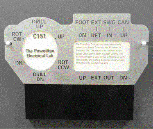 Speaking off the cuff, Main referred to the occasion as a “special event.” This training center will benefit mine safety long into the future, he said, and it has the opportunity to change the culture and move mine safety in the right direction in this country. Main should know. He helped develop several training centers earlier in his career. For those who remember the 1970s, there were many training centers throughout the coalfields that no longer exist today.
Speaking off the cuff, Main referred to the occasion as a “special event.” This training center will benefit mine safety long into the future, he said, and it has the opportunity to change the culture and move mine safety in the right direction in this country. Main should know. He helped develop several training centers earlier in his career. For those who remember the 1970s, there were many training centers throughout the coalfields that no longer exist today.
Reading from a prepared statement, Main said, “When the U.S. Attorney’s Office for the Southern District of West Virginia executed the non-prosecution agreement with Alpha Natural Resources on December 6, 2011, the stage was set for change in mine safety in Appalachia and throughout the country, including a change in the culture that existed as far as mine safety. Following the UBB disaster, it became abundantly clear that change was necessary. Miners need to be better protected from injuries, illness and death. We all knew that miners deserved better than the level of safety that existed. We knew we needed to get better at what we do and we have.
“The action from the U.S. Attorney’s Office has brought about much of the change we are seeing here today,” Main said. “As the new employer for the Massey Energy miners, Alpha Natural Resources was able to chart a new course. Through the [Dec. 6] agreement, a number of commitments were made by Alpha to bring about better, safer mining practices. This not only benefits the former Massey Energy miners, but all miners in West Virginia and throughout the country.”
“The improvement the U.S. coal industry is seeing today in reduced fatalities and injury rates is a credit to everyone who has ‘leaned in’ to identify ways to make mine health and safety a central focus. Having said that, we are going to work vigilantly to make sure that these gains do not slip away,” Main said.
Quinn said the event showcases the best capabilities of the U.S. coal industry. “Alpha’s Running Right Leadership academy not only demonstrates the company’s commitment to the health and safety of its workforce, it also demonstrates the leadership that every industry needs: companies like Alpha to set exemplary standards for others to follow,” Quinn said. “If the coal industry could be divided between leaders and followers, Alpha shows today why it’s among the true leaders in our industry.
“When we speak of leadership in the care and safety of our workforce, it begins with taking responsibility, and accepting ownership for ensuring that miners benefit from best-in-class training, technology, and most importantly a true culture of safety—one built on a foundation of shared commitment,” Quinn said. “These are fundamental principles of both Alpha’s Running Right philosophy and NMA’s CORE Safety initiative.” NMA’s CORE Initiative has set two very clear industry-wide safety goals: zero fatalities and reduce the injury rate by 50% over the next five years.
It’s no coincidence the two are so closely aligned. Crutchfield was part of the team of several mining industry CEOs that set the vision and formulated the expectations for the CORE Safety initiative. “Both programs reflect a safety culture that is proactive rather than reactive,” Quinn said. “Ones that analyze and anticipate what should be done to safeguard miners with a systematic approach that identifies safety challenges and then applies the appropriate resources and measures to meet them. This idea is beginning to take a firm hold in American mining.” Quinn concluded by saying that history will judge [the academy dedication] as one of most transformative moments for the U.S. coal mining industry.
The Road to Zero
A little more than two years have passed since Massey Energy officially became part of Alpha Natural Resources. “We knew going into this we had a big piece of work ahead of us,” Crutchfield said. “We knew we were squarely in the spotlight. We knew that change had to occur and expectations were high. We knew we had to make good on the promise of Running Right. A lot of things needed mending and it wasn’t going to happen overnight.”
Crutchfield acknowledged the skeptics. Above all, he believes they wanted to see how serious Alpha was about this new Running Right program. “Today, we stay the course with this enduring answer: Nothing matters more to this company than the safety of our people,” Crutchfield said. “It has to be and will continue to be at the core of everything we do.”
For the past two years, Alpha has set clear standards for safety and training and they have clear results to show for it. Crutchfield attributes the success to listening to the right people—the miners and the other employees whose safety hangs in the balance. “We have made steady and notable progress, but we have not reached our ultimate destination,” Crutchfield said. “We are committed to the long-term journey. It’s our steadfast belief that people want to do the right thing. It’s our job to put them in a position to do just that.”
Running Right gives everyone a voice, Crutchfield explained. “If something is amiss or needs improvement, or works especially well, we want to know about it. And, we do that with a steady stream of suggestions and observations about safety procedures in action,” Crutchfield said. “When 12,000 employees produce in excess of 50,000 suggestions per month, I would say the old ways are being ushered out and we’re replacing them with a culture of safety and trust.”
Last year close to 100 mines, plants and work groups within the Alpha organization went the full year without a single reportable injury. “We know it can be done [zero fatalities],” Crutchfield said. “We have always given miners some of the hardest work there is. Fundamentally, we believe it is not unreasonable for them to come to work with the expectation of returning home safely and injury free after their shift is done.”
The mission for Alpha’s Running Right Leadership Academy is to provide miners with the finest tools, training and education so they can make an honest and noble living with less risk. “We believe we are doing our part by putting them in a position to do theirs,” Crutchfield said. “So far as I know, this new campus has no equal anywhere in the world. It took a significant commitment of resources to get it this far, and we have no intention of letting up. The Running Right Leadership Academy begins its existence today as the best safety academy in coal mining. We aim to keep it the best year in and year out as we continue our safety journey.”
The training at the academy will immerse coal miners in controlled conditions simulating what could happen underground. It will allow them to experience different situations with experts sitting beside them as a coach. The final curriculum will include everything from EMT training to electrical training and retraining, engineering, management and leadership.
“Last year, we trained 2,300 certified mine examiners across the coalfield regions,” Crutchfield said. “Now we will have the facility to do that in one location. It has the latest cutting-edge technologies, as far as air flow sensors, oxygen cascading systems, proximity detection, coal dust explosibility meters and virtual simulators. The goal here is preparation.”
One day in the near future, Crutchfield explained, the academy will offer training to miners across the industry. Alpha’s goal is to partner with the very best and extend the welcome mat to others, eventually making the Running Right Leadership Academy an international training academy and a center of excellence.
“There is never an excuse to compromise on safety,” Crutchfield said. “If there is one thing I expect of myself as the leader of Alpha, it is to do everything I can to make life better and safer for all of the people of this company. I want to be sure that when health and lives are on the line, that there was nothing more we could have done—not one thing. So I can look my brothers and sisters straight in the eye and tell them that we have done our very best. They give nothing less to Alpha, and they deserve nothing less from me.”
Crutchfield concluded by recognizing two of Alpha’s trainers who worked hard to bring the academy to life: Keith Hainer, senior vice president operations performance group; and Cheryl Stapleton, director of learning and development. He thanked the U.S. Attorney’s Office for the Southern District of West Virginia. “Booth Goodwin and his team showed a deep and sincere interest in the creation of this facility,” Crutchfield said.
The lights dimmed. Dozens of miners with cap lamps grabbed a lifeline, encircled the audience and approached the podium. Others stretched on a long series of mine belts connected together. “Alpha formally dedicates the academy to the memory of the generations of coal miners who came before us, the coal miners who are with us today, and the coal miners of the future,” Crutchfield said. Then he, the First Lady of West Virginia and several other dignitaries broke the chain of miner’s belts in a ribbon-cutting like fashion.
The Leadership Academy
The Running Right Leadership Academy sits on 10 acres of reclaimed mine lands. It consists of four main buildings and a small utility building. To develop trainers, Alpha taps into subject matter experts throughout its operations and production groups. They participate in a program to learn how to be effective trainers. Once they are certified, they serve as adjunct instructors. The academy currently relies on a dozen full-time staffers and 35 to 40 adjunct instructors.
As far as the curriculum, the academy has focused on specific roles for the remainder of 2013. Every underground coal miner—whether it’s for annual retraining or safety observation training (a program specific to Alpha)—will have to go through some form of training. “We’re poised between now and the end of the year to train 3,000 to 4,000 employees,” Stapleton said. “Since the beginning of June, we have trained 300 to 400 employees—that was our soft launch.” As far as the curriculum development for 2014, Stapleton said they are currently determining their needs.
“When we were developing the academy, we wanted to provide a comprehensive training program that would engage everyone from the new miners to the 30-year veterans. The virtual simulators appeal to the Xbox generation. Similarly, the experienced miners recognize the gear in the electrical-mechanical labs. Then we have the crown jewel: the 96,000-sq-ft simulated mine. That’s where they spend a lot of their days with real equipment before they go underground.”
Previously, an annual electrical retraining class would spend a lot of classroom time discussing theory, Hainer explained. “Now, instead of looking at photos and diagrams in the classroom, we can take them to the simulated mine and ask them to give an examination on the shuttle car,” Hainer said. “Then we can critique how well they performed that exercise and offer constructive feedback. That’s a big advantage.”
Simulators & 3-D Training
The academy has five of the best mining-industry simulators in one room. They purchased simulators from both 5DT and Immersive Technologies. “We like different aspects of both companies,” Hainer said. “As far as underground equipment, we have two continuous miner simulators, a roof bolter and a shuttle car. We also have a Cat 785 rock truck because it was most representative of the surface mining equipment we operate.”
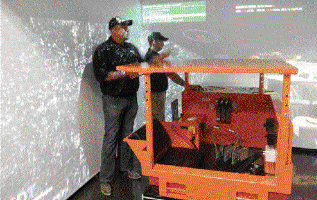 Using the data collectors, the trainers can catalog operator errors. “We can see where they started and how they finished and what they retained,” Hainer said. “The trainer can change the environment and trigger failures. Then they monitor how the operators react to a hazard, such as an engine fire, a tire rupture, or a mechanical or hydraulic failure.
Using the data collectors, the trainers can catalog operator errors. “We can see where they started and how they finished and what they retained,” Hainer said. “The trainer can change the environment and trigger failures. Then they monitor how the operators react to a hazard, such as an engine fire, a tire rupture, or a mechanical or hydraulic failure.
“When we standardize our operations, we minimize risk exposures, which increase safety and production,” Hainer said.
The Alpha Academy has the latest Joy 14CM15 simulator set up with proximity detection from Immersive Technologies. It can also be set up with hazards such as methane and fire. Cable management is an important part of the program. The operator acknowledges the position of the continuous miner cable by illuminating it with his cap lamp. The cable turns green and moves out of the way. The operator signals a shuttle car operator and flags him forward with his cap lamp and waves him off.
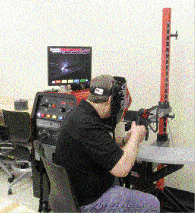 All of the levers on the 5DT roof bolter simulator are arranged just like a J.H. Fletcher roof bolter. “The great thing about this simulator is the timing,” Hainer said. “Teaching muscle memory is an art form. The importance of the mix time, hold time and set time is vitally important. We can’t teach that underground in an operating coal mine unless the trainer is standing beside each new bolter operator with a stopwatch. Here we can get someone to see how they should set and get a feel for proper time through repetition. These are simulators. We still have training when we get to the face.”
All of the levers on the 5DT roof bolter simulator are arranged just like a J.H. Fletcher roof bolter. “The great thing about this simulator is the timing,” Hainer said. “Teaching muscle memory is an art form. The importance of the mix time, hold time and set time is vitally important. We can’t teach that underground in an operating coal mine unless the trainer is standing beside each new bolter operator with a stopwatch. Here we can get someone to see how they should set and get a feel for proper time through repetition. These are simulators. We still have training when we get to the face.”
Adjacent to the simulator bays is a vertical theatre-style classroom. It has a 16-ft wide screen for training a group of people. “We can place several people, such as miners and mine examiners, in a simulated mine together,” Hainer said.
Electrical & Mechanical Labs
The hands-on equipment in the electrical and mechanical labs allows mechanics and electricians to hone their skills. The company has trained 567 electricians from beginner to state-certified levels, exceeding state expectations by 1,000% as far as training. More than 50% of the training is for safety and compliance.
One arrangement, for example, resembles a typical prep plant circuit. Trainers can demonstrate how a change in the set point affects the processes in the plant. Today PLCs and VFDs control valves and motor speeds and they react quickly to changes in settings. In the lab, it is much easier to visualize this than in the actual plant. In another section of the lab, they have all electrical panels for shuttle cars and continuous miners. The trainers can activate faults through a toggle switch. Using a print and an instrument, apprentices learn to find the faults.
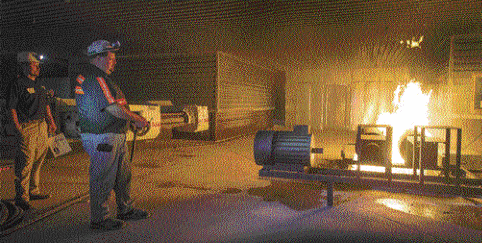 Alpha started its welding program in 2001. A virtual welding machine allows welders to weld in a number of different angles and thicknesses of metals in a smoke-free environment. The computer describes the quality of the bead. It will tell the welder whether his angle, settings and speed are correct. It can perform a bend test to see if the weld will fail. The student can weld pipe and the program will tell him if the pipe will leak. In another training area, the academy has a dozen welding bays. Each bay has its own hood and they have mine power available so they can move continuous miners and shuttle cars in and out of the facility.
Alpha started its welding program in 2001. A virtual welding machine allows welders to weld in a number of different angles and thicknesses of metals in a smoke-free environment. The computer describes the quality of the bead. It will tell the welder whether his angle, settings and speed are correct. It can perform a bend test to see if the weld will fail. The student can weld pipe and the program will tell him if the pipe will leak. In another training area, the academy has a dozen welding bays. Each bay has its own hood and they have mine power available so they can move continuous miners and shuttle cars in and out of the facility.
Underground Mine Lab
The 96,000-sq-ft underground mine lab has eight entries and seven crosscuts, which are 20-ft wide, just as they are underground. The large concrete block building uses walls constructed from aluminum siding (painted black) to give the effect of pillars and ribs. With a gravel floor, it has been constructed to resemble a room-and-pillar mining operation with various stations, such as a continuous miner with proximity detection, a roof bolter, a refuge chamber, a cascading oxygen system and a feeder along with a conveyor drive. Variable speed fans allow the trainers to recreate any ventilation scenario. The air courses are separated with Kennedy stoppings and lifelines hang from the top.
The Oxygen Cascading System allows miners to recharge the tanks on their self-contained breathing apparatus (SCBA) without removing the gear. Using quick couplings and whips, five miners could recharge tanks at the same time in 45 to 90 seconds without breaking the seal on their masks. The module the trainers were using was set up for 16 apparatuses and it could charge 30 tanks from 0 to 4,500 psi.
Alpha has implemented oxygen cascading systems at two mines (Cucumber and Hunter Peerless) and another is currently being installed in a third mine. Draeger manufactures one system (ChargeAir) and MineLifeline makes another (ModAir). They have a ChargeAir system installed at the Cucumber mine and a ModAir system at the Hunter Peerless mine.
Alpha also demonstrated its new technology for airflow monitoring. It uses three sensors to monitor air flow velocity and direction, methane and carbon monoxide (CO) continuously from a surface location. The units will be placed in every intake, return and neutral air course at each of the company’s active underground sections.
“There was nothing on the market so we developed an airflow monitor, which consists of two thermal sensors with a heat resistor between them,” said Terry Theys, director of safety engineering. “The air flow across them creates a temperature change, and the difference is monitored and fed to the data collection system.”
The CO sensor is an electrochemical device developed by Matrix that has been available for about a year. The methane monitor uses a highly accurate infrared sensor. The system reports wirelessly to a central control room. “We have developed a gateway to convert the information for Alpha’s atmospheric monitoring system,” Theys said. “Otherwise we would have had to develop four different AMS systems.”
During a demo, Theys showed how the system noticed that ventilation had reversed from 700 cubic feet per minute (cfm) to -300 cfm. The operator at the central control room receives an alarm immediately. He can alert personnel. “Until now, that situation would never have been identified unless a mine examiner had recently passed through that immediate area,” Theys said.
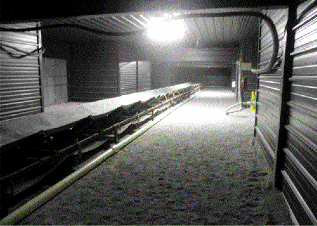 Alpha was expecting approval on the entire system from MSHA’s ACC group soon. They are currently manufacturing the componentry. “We will start installing them in August,” Theys said. “We will have them in every active production split before December. This is the next generation in mine monitoring systems.”
Alpha was expecting approval on the entire system from MSHA’s ACC group soon. They are currently manufacturing the componentry. “We will start installing them in August,” Theys said. “We will have them in every active production split before December. This is the next generation in mine monitoring systems.”
The underground mine lab has a refuge station for training purposes. At another similar looking station, Alpha had a fresh air base from Australia on display. Although it appeared to be a refuge chamber, it was not. The unit simply allows miners wearing an SCSR to rest during their journey in a positive displacement atmosphere. Miners wearing an SCSR cannot remove their mouth piece. This unit allows them a chance to cool off, get a drink of water, and get their bearings. It will hold 30 miners comfortably.
The simulated mine has a Joy 14CM15 continuous miner with Joy-Matrix proximity detection. They selected this unit because it most closely resembles what Alpha is using in the field, 75% of the company’s 184 continuous miners.
The miner operator wears a locator and it forces him to stand in a place of safety, explained Mike Fletcher, captain of Chapmanville mine rescue team. As the operator approaches the continuous miner, a warning signal activates with an audible and visual tone. The continuous miner will still function. “When he gets too close, the signal turns red with a solid audible tone,” Fletcher said. “It will de-energize the tram and stop the swing on the boom, so that the continuous miner cannot harm the operator. In his place of safety, he hears no audible tone and he sees a green light. Speaking as a former continuous miner operator, I understand how important it is for a miner to stay out of the red zone.”
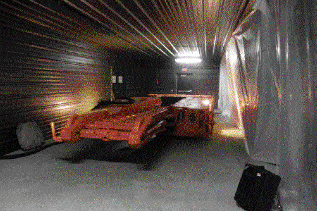 Alpha currently has 37 continuous miners equipped with proximity detection. They expect to get 30 more equipped by the end of the year.
Alpha currently has 37 continuous miners equipped with proximity detection. They expect to get 30 more equipped by the end of the year.
In another area of the simulated mine, they have a feeder and what appears to be a belt drive at first glance. A sound system creates the sound effect of belt splices moving over rollers. It’s actually a live control burn area. Two large cylinders that look like mufflers are assembled as a head drive. This simulator burns liquid propane to get the temperature as high as it would be in a real situation. Rescue teams can practice firefighting under full apparatus. A smoke machine adds to the effect. There is an overhead sprinkler just in case things get out of hand.
Alpha also demonstrated the Sensidyne coal dust explosibility meter, which it hails as one of the best preventive tools available today. MSHA requires a minimum of 80% rock dust. To test those samples, typically they would bag up a sample and send it to a lab to test it, which takes time. Underground, miners need to make a visual determination quickly. With this meter, they can go underground take a sample and test it on site. They are lightweight and permissible and it tells the miners immediately where they need more rock dust.
They have one to two of these Sensidyne devices at each of its operations. They have been using them for 18 months. The whole kit costs approximately $3,000. As far as accuracy, the readings are within 2% of a low temperature ash test. Alpha’s labs, MSHA’s labs, and independent (outside) labs have verified the accuracy of the Sensidyne device. The company anticipates it will take 2,500 non-regulatory samples per quarter.
A Milestone along the Safety Improvement Continuum
The Running Right Leadership Academy represents a significant investment for Alpha and it will cost a lot of money to operate it. “We have a lot of support for it, especially from the board of directors and the senior management,” Crutchfield said. “It’s a demonstration of our commitment. This facility will bring together talented people to share thoughts regarding best practices.”
Crutchfield explained that Alpha was considering a similar training facility prior to the Massey Energy merger. “We had been kicking the idea around,” Crutchfield said. “I give the U.S. Attorney’s Office credit because they were very supportive. There was great symmetry in the spirit and the purpose of this and our philosophy of Running Right.”
A lot of companies in the same situation would have made the investment, checked the box, and said they have done what they were asked to do, Vining explained. “Alpha took the measures to make this facility extraordinary,” Vining said. “This facility integrates a lot of safety and training skills from around the world and gathers into one location to give people hands-on experience and the capability of seeing what they will see before they ever set foot underground.”
When asked about the cultural transition the company has made since it merged the Massey Energy operations, Crutchfield explained that the company has made a lot of progress. “But to say it’s complete, would be an overstatement,” Crutchfield said. “This dedication of this facility is a tangible sign in a journey.” Everyone would agree that this is a positive step in the right direction.




